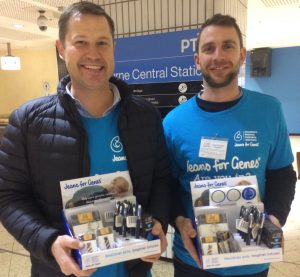One in 20 Australian children are born with birth defects and genetic diseases. That is one child per classroom.
18-year-old University of New South Wales student, Jennifer was diagnosed with the immune system disease, Systemic Lupus Erythematosus (Lupus SLE) at just 14 years of age.
Lupus SLE is an autoimmune disease, where the immune system produces antibodies that attack the body’s own healthy tissue. Symptoms can be vague and vary from person to person, making diagnosis extremely difficult.
Today, Jennifer is volunteering at Jeans for Genes Day in Sydney, striving to raise awareness and support others living with genetic diseases.
Log in or sign up to view
See posts, photos and more on Facebook.
For Jennifer, her diagnosis of Lupus SLE crept up on her unexpectedly. At first, she was experiencing pain in her knee joints, making it difficult to move around. Then a few weeks later, she was diagnosed. Even in the early days, Jennifer says she knew something wasn’t right.
“I had a few weeks of weird knee pain and it was hard to walk … the knee joint didn’t work at all,” she says.
“There was also little bumps on my finger tips, which I have never had before.”
“I told my parents and they took me to the GP, got a blood test and it came back with Lupus.”
More than 20,000 people in Australia and New Zealand are diagnosed with Lupus. The condition generally develops between the ages of 15 – 45 and 9/10 people affected are women. The risk of developing Lupus amongst children also heightens in adolescent years.
After being diagnosed, Jennifer’s life changed. In her junior high school years at the time, she faced the challenges of manoeuvring through the often-crowded corridors to classes, whilst carrying her schoolbooks and items.
“It was definitely hard to get around. I was still in high school, so I still had to walk around and carry my heavy bag, which was really hard,” she shares.
“I tried to make it less impacting, the condition itself. Only carry some books and tell the school so they would understand if I don’t bring some things or don’t complete a task as usual.”
There are several different types of Lupus, which differ significantly in the type and severity of symptoms. Lupus SLE remains the most common form and is characterised by a seesaw of ‘flare-ups’ and periods of improvement.
In most people, joints and skin are the main body parts affected – 50 per cent of people with lupus experiencing joint pain or swelling. Another 20 per cent experience skin rashes, which worsen with sun exposure and 10 per cent of people, live with fatigue.
Jennifer takes medication in order to subside the pain, which enables her to life an almost-normal life.
She is now studying a Bachelor of Commerce at the University of New South Wales, attending classes a few days per week. But there are still days her condition goes up and down.
“I feel just normal, but I take medication everyday,” she says.
“But sometimes especially during the colder weather, it does get a little bit worse … but other than it is completely normal.”
Like thousands across the country today, Jennifer is a Jeans for Genes Day volunteer. The national denim fundraiser supports the Children’s Medical Research Institute (CMRI) find treatments and cures for the one in 20 Australian children living with birth defects and diseases.
While the denim theme is light-hearted and fun, the sad reality is that every year 300 children in Australia lose their lives to childhood disease.
[infogram id=”jeans_for_genes_day” prefix=”nPT” format=”interactive” title=”Jeans For Genes Day”]Jeans for Genes Day, national campaign manager Barry Kenyon says the number of children living with genetic diseases and defects is significant.
“It’s so important in the fact that so may people are aware of that alarming statistic which actually translates to one child in every classroom,” he says.
This year marks the 24th year of the nation-wide campaign and the support it brings to the CMRI. Over the last 24 years $67 million has been raised through donations, all of which has gone to treatment and cure research, aiming to give children the best chance at a healthy life.
“The money we raise at Jeans for Genes Day goes directly to the research labs … the $67 million that the public have donated over the last 24 years, without that sort of contribution a lot of the breakthroughs we have discovered wouldn’t have happened.”
Log in or sign up to view
See posts, photos and more on Facebook.
The CMRI hopes that through the advances of technology and greater research, the alarming statistics of childhood diseases will decrease.
“What we are finding is that the more technology available to us, the more we are able to actually uncover,” Kenyon says.
“Better screening, better treatments and cures are certainly helping to reduce that number.”
Other people supporting the fundraiser includes former gold medallist Libby Trickett, who was inspired to get behind the cause after a scare at her 20-week scan with daughter, Poppy. Fashion and Lifestyle Blogger, Nadia Bartel and Family Feud presenter, Grant Denyer.
While others are out on the streets, in workplaces and schools rocking their denim jeans.

Volunteers Scott and David inside Melbourne Central Station. (Photo: Chanel Zagon)
#Jointhemovement17 #JeansForGenesAU.


